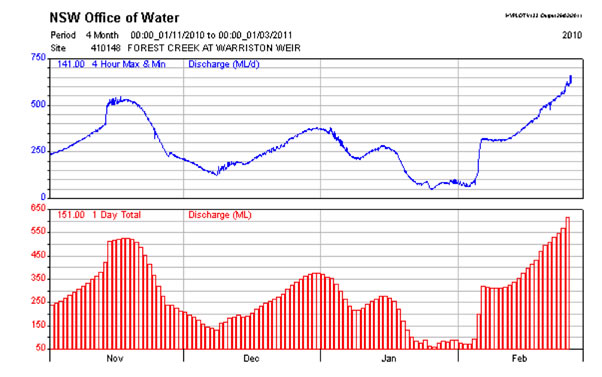25 February 2011
An update for those interested in the water bird breeding event at Wanganella swamps (a.k.a. the 8 Mile Creek/Forest Creek system south of Wanganella).
We had a crisis in January when water levels at the Wanganella swamps dropped dramatically, seemingly the result of a malfunctioning electronic gauge in the Billabong Creek, the swamps’ water source. (Apparently NSW State Water believed there was more water in the system than was the case).
Within a week the water level at the 8 Mile bridge on the Hay Road, where I have been keeping an eye on the gauge, dropped from .6 to .3 (600 mm to 300 mm). My turn to malfunction! (The 8 Mile Creek gauge is a piece of metal with numbers stuck in the water — works every time).
8 Mile Creek gauge 0.33 January 28, 2011 P Maher 8 Mile Creek gauge 0.55 February 8, 2011 P Maher We had only one real heat wave this season and naturally it coincided with this sudden fall in water depth coupled with one of the few dry periods of the summer. After so many years of drought and water birds not being able to breed, this was a soul-destroying scenario. The hot weather/very low water level combination wreaked havoc on large numbers of juvenile coots, swamphens and assorted ducks with some birds appearing to have died of botulism. Parts of the ibis rookery dried out leaving thousands of young ibis vulnerable. Without a shadow of a doubt this would all have ended in disaster had the area not caught the tail end of cyclones Anthony and Yasi, which dumped about 100 mm of rain on Wanganella over a couple of days. The creek system rose almost immediately.
stranded whiskered tern chicks 28 January 2011 The Dept. of Environment, Climate Change and Water had organised some environmental water but because of inadequate delivery systems this was still at least a week away from the swamps. (Environmental water, it should be noted, is not easily or quickly obtained).
The swamps have been rising steadily since that colossal rain event of 4, 5, 6 February and will continue to rise as more floodwater makes its way down the Billabong Creek. (The Billabong has its beginnings up in the Holbrook area).The drop in water levels in the latter part of January has probably knocked on the head any breeding prospects for Australasian bitterns, which nest in shallow spikerush swamps. There was only one bird calling on 16 January, my last bittern record for these swamps. I have not known them to breed so late in the summer but perhaps the more conducive current water levels will prompt a breeding attempt. Many local birds have been in a breeding frenzy since the breaking of the drought. With the scarcity of rice crops and other breeding habitat during that time Australasian bitterns must be particularly anxious to breed.
I have only one breeding record for musk duck for the ‘Wang’ swamps, that being a juvenile recorded on 8 February and no breeding records for blue-billed ducks. Both species seem to have left the 8 Mile Creek system; I was hoping for a better outcome for these ducks. Both species are still at the swamps to the north of Wanganella and with the benefit of stable water levels and non-government management I am expecting them to breed.
To give the Dept of Environment their due, the 8 Mile Creek system has its challenges. The 2010/2011 season has been instructive; hopefully future waterbird breeding events will benefit from knowledge gleaned in this current one.
The Billabong Creek meanders through flat terrain and when its flows reach the Forest Creek and spill over Warriston Weir it will take another two weeks before it enters the Wanganella swamps, so a drop in water levels in the swamps cannot be restored quickly. The trick is to get environmental water in early and keep it coming until water birds have completed breeding.
Further information on this water bird breeding event can be found at the Wanganella breeding waterbird notes
There is a short history of the 8 Mile/Forest Creek system on the Wanganella swamps photo page.
white ibis chick 18 January 2011 eggs of straw-necked ibis 18 January 2011 drying out swamp 18 January 2011 dead young swan, cause unknown 28 January 2011 Abandoned nest of hoary-headed grebes, Wanganella Station, 28 January 2011 P Maher Abandoned nest of hoary-headed grebes, Wanganella Station, 28 January 2011 P Maher

source: http://waterinfo.nsw.gov.au/
Megalitres over Warriston Weir on the Forest Creek from 1 November 2010 to 26 February 2011